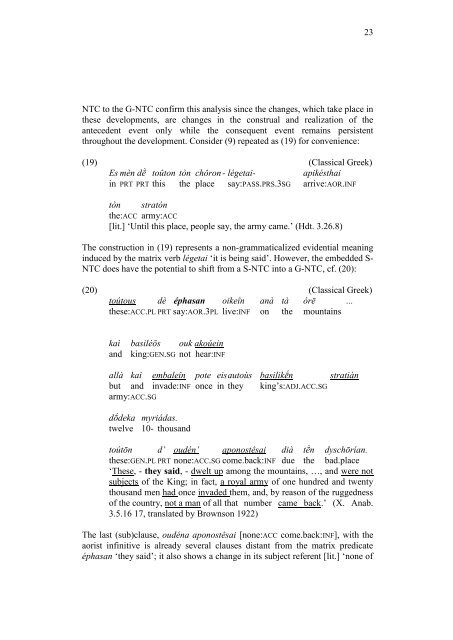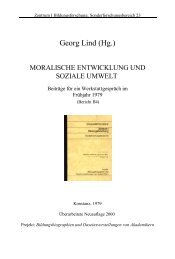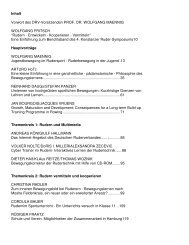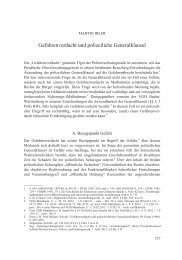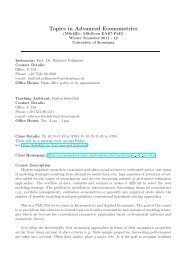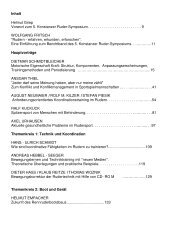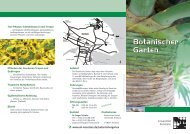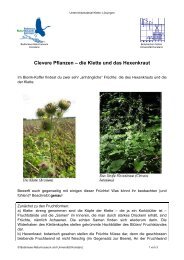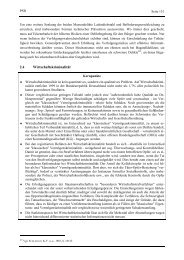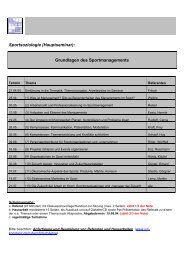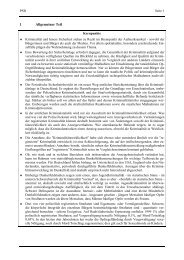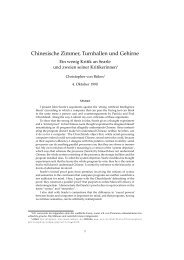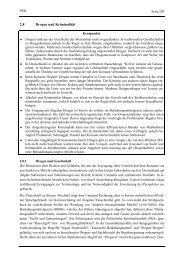Subjects and non-subjects in constructions
Subjects and non-subjects in constructions
Subjects and non-subjects in constructions
You also want an ePaper? Increase the reach of your titles
YUMPU automatically turns print PDFs into web optimized ePapers that Google loves.
23<br />
NTC to the G-NTC confirm this analysis s<strong>in</strong>ce the changes, which take place <strong>in</strong><br />
these developments, are changes <strong>in</strong> the construal <strong>and</strong> realization of the<br />
antecedent event only while the consequent event rema<strong>in</strong>s persistent<br />
throughout the development. Consider (9) repeated as (19) for convenience:<br />
(19) (Classical Greek)<br />
Es mèn dḕ toûton tòn chôron - légetai-<br />
apikésthai<br />
<strong>in</strong> PRT PRT this the place say:PASS.PRS.3SG arrive:AOR.INF<br />
tòn stratón<br />
the:ACC army:ACC<br />
[lit.] „Until this place, people say, the army came.‟ (Hdt. 3.26.8)<br />
The construction <strong>in</strong> (19) represents a <strong>non</strong>-grammaticalized evidential mean<strong>in</strong>g<br />
<strong>in</strong>duced by the matrix verb légetai „it is be<strong>in</strong>g said‟. However, the embedded S-<br />
NTC does have the potential to shift from a S-NTC <strong>in</strong>to a G-NTC, cf. (20):<br />
(20) (Classical Greek)<br />
toútous dè éphasan oikeîn anà tà órē ...<br />
these:ACC.PL PRT say:AOR.3PL live:INF on the mounta<strong>in</strong>s<br />
kaì basiléōs ouk akoúe<strong>in</strong><br />
<strong>and</strong> k<strong>in</strong>g:GEN.SG not hear:INF<br />
allà kaì embaleîn pote eis autoùs basilikḗn stratiàn<br />
but <strong>and</strong> <strong>in</strong>vade:INF once <strong>in</strong> they k<strong>in</strong>g‟s:ADJ.ACC.SG<br />
army:ACC.SG<br />
dṓdeka myriádas.<br />
twelve 10- thous<strong>and</strong><br />
toútōn d‟ oudén‟ aponostêsai dià tḕn dyschōrían.<br />
these:GEN.PL PRT <strong>non</strong>e:ACC.SG come.back:INF due the bad.place<br />
„These, - they said, - dwelt up among the mounta<strong>in</strong>s, …, <strong>and</strong> were not<br />
<strong>subjects</strong> of the K<strong>in</strong>g; <strong>in</strong> fact, a royal army of one hundred <strong>and</strong> twenty<br />
thous<strong>and</strong> men had once <strong>in</strong>vaded them, <strong>and</strong>, by reason of the ruggedness<br />
of the country, not a man of all that number came back.’ (X. Anab.<br />
3.5.16 17, translated by Brownson 1922)<br />
The last (sub)clause, oudéna aponostêsai [<strong>non</strong>e:ACC come.back:INF], with the<br />
aorist <strong>in</strong>f<strong>in</strong>itive is already several clauses distant from the matrix predicate<br />
éphasan „they said‟; it also shows a change <strong>in</strong> its subject referent [lit.] „<strong>non</strong>e of


